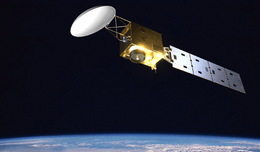EarthCARE
EarthCARE (derived from Earth Clouds, Aerosols and Radiation Explorer) is a planned joint European/Japanese (ESA / JAXA / NICT) satellite, the sixth of ESA's Earth Explorer Programme.[1] The main goal of the mission is the observation and characterization of clouds and aerosols as well as measuring the reflected solar radiation and the infrared radiation emitted from Earth's surface and atmosphere.[3][4][5]
 Artist's view of EarthCARE | |
| Mission type | Earth observation |
|---|---|
| Operator | ESA / JAXA / NICT |
| Website | EarthCare on esa.int |
| Mission duration | 3 years (planned) |
| Spacecraft properties | |
| Bus | AstroBus-L |
| Manufacturer | EADS Astrium |
| Launch mass | 2350 kg [1] |
| Dry mass | 2037 kg [1] |
| Dimensions | 2.5 x 19 m |
| Power | 1700 watts |
| Start of mission | |
| Launch date | June 2022 [2] |
| Rocket | Soyuz ST-B / Fregat-MT |
| Launch site | Centre Spatial Guyanais, ELS |
| Contractor | Arianespace |
| Orbital parameters | |
| Reference system | Geocentric |
| Regime | Sun-synchronous |
| Altitude | 393 km |
| Inclination | 97,1° |
| Period | 92,5 minutes |
| Repeat interval | 25 days |
| Epoch | Planned |
| Transponders | |
| Band | S Band (TT&C support) X band (science data acquisition) |
| Bandwidth | 2 Mbit/s download (S Band) 150 Mbit/s download (X Band) 64kbit/s upload (S Band) |
| Instruments | |
| ATLID: ATmospheric LIDar CPR: Cloud Profiling Radar MSI: Multi-Spectral Imager BBR: Broad-Band Radiometer | |
 | |
History
In May 2008, ESA signed a contract worth €263 million (£220 million/US$360 million) with EADS subsidiary Astrium. As the prime contractor, Astrium is responsible for the satellite's design, development and integration.[6] Design and construction began in early 2009[7] while launch is set for June 2022.[2]
EarthCARE is an acronym standing for Earth Clouds, Aerosols and Radiation Explorer, and the aims of the mission are to improve understanding of the cloud, radiative and aerosol processes that affect the Earth's climate.[8] As of January 2011, the total budget for the project is £500 million (€590 million/US$810 million).[7] A significant proportion of the project will be manufactured in the UK, the main structure of the spacecraft will be built by RUAG Space in Switzerland and subsequently completed in Astrium's Stevenage facility, while one of the instruments will be made in Sevenoaks by SSTL and another in Bristol, Somerset by SEA Group Ltd, now part of Thales Alenia Space UK.[7] In September 2014, ESA and JAXA held a joined EarthCARE International Science Workshop.[9] From 2014 to 2015, an ongoing integration of the instruments took place.[9] In 2015, launch was postponed to 2018 due to problems with lidar development.[10] Launch is currently set for June 2022.[2] EarthCARE is the largest and most complex Earth Explorer mission to date.
Mission
The mission is to provide a picture of the 3D-dimensional spatial and the temporal structure of the radiative flux field at the top of the atmosphere, within the atmosphere and at the Earth's surface. The high-performance lidar and radar technology, plus the synergistic use of the different remote sensing techniques embarked on board EarthCARE, will deliver unprecedented datasets allowing scientists to study the relationship of clouds, aerosols, and radiation at accuracy levels that will significantly improve our understanding of these highly-variable parameters. The mission will provide this information to improve predictions about the weather and future climate.[11]
Science
The satellite will make measurements useful for a better understanding of the Earth's thermal and solar radiation balance. In particular, a combination of active (lidar and radar) and passive (radiometers and imagers) instruments will enable EarthCARE to simultaneously measure the vertical and horizontal distribution of clouds and atmospheric aerosols along with Top-Of-Atmosphere (TOA) Long- and Short-wave fluxes.
The spacecraft will feature four distinct instruments:[1]
- ATmospheric LIDar (ATLID) - ESA - 354.8 nm, high-spectral resolution and depolarisation (aerosols).
- Cloud Profiling Radar (CPR) - JAXA / NICT - 36 dBZ sensitivity, 500 m horizontal and 100 m vertical sampling resolution, Doppler capability (clouds).
- Multi-Spectral Imager (MSI) - ESA - 7 channels, 150 km swath, 500 m pixel resolution (clouds and aerosols).
- Broad-Band Radiometer (BBR) - ESA - 2 channels, 3 views (nadir, fore and aft) (radiations).
See also
- ESA's Living Planet Programme
References
- Eisinger, Michael; et al. (26 November 2018). EarthCARE The Earth Cloud, Aerosol and Radiation Profiling Satellite Mission (PDF). ATMOS-2018. Salzburg, Austria: ESA. Retrieved 27 May 2019.
- "Arianespace and ESA announce EarthCare launch contract". Arianespace (Press release). 28 October 2019.
- "EarthCARE - Earth Online - ESA". ESA. Retrieved 19 September 2017.
- Illingworth, A. J.; Barker, H. W.; Beljaars, A.; Ceccaldi, M.; Chepfer, H.; Clerbaux, N.; Cole, J.; Delanoë, J.; Domenech, C.; Donovan, D. P.; Fukuda, S.; Hirakata, M.; Hogan, R. J.; Huenerbein, A.; Kollias, P.; Kubota, T.; Nakajima, T.; Nakajima, T. Y.; Nishizawa, T.; Ohno, Y.; Okamoto, H.; Oki, R.; Sato, K.; Satoh, M.; Shephard, M. W.; Velázquez-Blázquez, A.; Wandinger, U.; Wehr, T.; van Zadelhoff, G.-J. (2015). "The EarthCARE Satellite: The Next Step Forward in Global Measurements of Clouds, Aerosols, Precipitation, and Radiation" (PDF). Bulletin of the American Meteorological Society. 96 (8): 1311–1332. Bibcode:2015BAMS...96.1311I. doi:10.1175/BAMS-D-12-00227.1. ISSN 0003-0007.
- "EarthCARE (Earth Clouds, Aerosols and Radiation Explorer)". ESA's eoPortal. Retrieved 2013-10-30.
- "EarthCARE satellite contract signed". ESA. 27 May 2008.
- "Europe's Earthcare space laser mission gets go ahead". BBC. 18 February 2011. Retrieved 30 May 2015.
- "ESA's cloud, aerosol and radiation mission". ESA. 19 February 2013.
- "ESA Bulletin 161 (1st quarter 2015)" (PDF). ESA. 2015. p. 70. ISSN 0376-4265. Retrieved 30 May 2015.
- de Selding, Peter B. (22 May 2015). "Cost, Schedule Woes on 2 Lidar Missions Push ESA To Change Contract Procedures". Spacenews.
- https://www.arianespace.com/press-release/ arianespace-and-esa-announce-earthcare-launch-contract/ - 28 October 2019